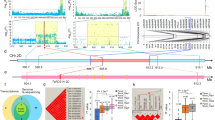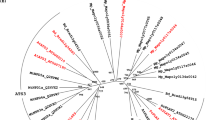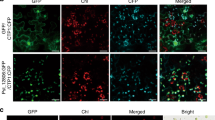Abstract
Key message
Expression of the TaMDC1 in transgenic tomato plants confer resistance to bacterial and fungal pathogens, as well as an insect pest and thus prove in planta function of the wheat cystatin.
Abstract
Cystatins are the polypeptides with cysteine proteinase inhibitory activities. Plant cystatins or phytocystatins are known to contribute to plant resistance against insect pests. Recently, increasing data proved that some of the phytocystatins also have antifungal activities in vitro. Here, we functionally characterized a wheat multidomain cystatin, TaMDC1, using in planta assays. Expression of TaMDC1 in wheat seedlings is up-regulated in response to methyl jasmonate and salicylic acid, indicating that TaMDC1 is involved in biotic stress responses mediated by these plant hormones. The TaMDC1 cDNA was integrated in tomato genome and expressed under cauliflower mosaic virus 35S promoter. Four transgenic plants that show high level of the transgene expression were selected by RNA gel blot and immunoblot analysis and utilized to assess biotic stress resistance against the bacterial pathogen Pseudomonas syringae, the fungal pathogens Botrytis cinerea and Alternaria alternata, and the insect pest Colorado potato beetle (CPB, Leptinotarsa decemlineata). Detached leaf inoculation assays revealed that the tomato plants expressing TaMDC1 showed high levels of resistance against P. syringae and A. alternata, and elevated tolerance against B. cinerea. Sustenance of L. decemlineata larvae to the transgenic plants demonstrated inhibition of CPB larvae growth. Inhibitory activity of TaMDC1 against selected pathogens was also demonstrated by in vitro assays with total protein extracted from transgenic tomato plants. Taken together, the presented data suggest that TaMDC1 is involved in a broad spectrum biotic stress resistance in planta.






Similar content being viewed by others
References
Alvarez-Alfageme F, Martinez M, Pascual-Ruiz S, Castanera P, Diaz I, Ortego F (2007) Effects of potato plants expressing a barley cystatin on the predatory bug Podisus maculiventris via herbivorous prey feeding on the plant. Transgenic Res 16:1–13
Arai S, Abe K (2000) Cystatin-based control of insects, with special reference to oryzacystatin. In: Michaud D (ed) Recombinant protease inhibitors in plants. Landes Bioscience/Eurekah.com, Georgetown, pp 27–42
Atkinson HJ, Urwin PE, Clarke MC, McPherson MJ (1996) Image analysis of the growth of Globodera pallida and Meloidogyne incognita on transgenic tomato roots expressing cystatins. J Nematol 28:209–215
Atkinson HJ, Urwin PE, McPherson MJ (2003) Engineering plants for nematode resistance. Annu Rev Phytopathol 41:615–639
Bouchard E, Cloutier C, Michaud D (2003) Oryzacystatin I expressed in transgenic potato induces digestive compensation in an insect natural predator via its herbivorous prey feeding on the plant. Mol Ecol 12:2439–2446
Brunelle F, Girard C, Cloutier C, Michaud D (2005) A hybrid, broadspectrum inhibitor of Colorado potato beetle aspartate and cysteine digestive proteinases. Arch Insect Biochem Physiol 60:20–31
Carrillo L, Herrero I, Cambra I, Sánchez-Monge R, Diaz I, Martínez M (2011a) Differential in vitro and in vivo effect of barley cysteine and serine protease inhibitors on phytopathogenic microorganisms. Plant Physiol Biochem 49(10):1191–1200
Carrillo L, Martínez M, Ramessar K, Cambra I, Castañera P, Ortego F, Díaz I (2011b) Expression of a barley cystatin gene in maize enhances resistance against phytophagous mites by altering their cysteine-proteases. Plant Cell Rep 30(1):101–112
Chan YL, Yang AH, Chen JT, Yeh KW, Chan MT (2010) Heterologous expression of taro cystatin protects transgenic tomato against Meloidogyne incognita infection by means of interfering sex determination and suppressing gall formation. Plant Cell Rep 29(3):231–238
Chen P-J, Senthilkumar R, Jane W-N, He Y, Tian Z, Yeh K-W (2014) Transplastomic Nicotiana benthamiana plants expressing multiple defence genes encoding protease inhibitors and chitinase display broad-spectrum resistance against insects, pathogens and abiotic stresses. Plant Biotechnol J 12(4):1–13
Cheng M-L, Tzen JTC, Shyu DJH, Chou W-M (2014) Functional characterization of the N-terminal and C-terminal domains of a sesame group II phytocystatin. Bot Stud 55(1):18–28
Christova P, Christov N, Imai R (2006) A cold inducible multidomain cystatin from winter wheat inhibits growth of snow mold fungus, Microdochium nivale. Planta 223:1207–1218
Cingel A, Savic J, Cosic T, Zdravkovic´-Korac S, Momcˇilovic I, Smigocki A, Ninkovic S (2014) Pyramiding rice cystatin OCI and OCII genes in transgenic potato (Solanum tuberosum L.) for resistance to Colorado potato beetle (Leptinotarsa decemlineata Say). Euphytica 198:425–438
Cingel A, Savić J, Lazarević J, Ćosić T, Raspor M, Smigocki A, Ninkovic S (2016) Extraordinary adaptive plasticity of colorado potato beetle: “Ten-Striped Spearman” in the era of biotechnological warfare. Int J Mol Sci 17(9):1538
Cloutier C, Fournier M, Jean C, Yelle S, Michaud D (1999) Growth compensation and faster development of Colorado potato beetle (Coleoptera: Chrysomelidae) feeding on potato foliage expressing oryzacystatin I. Arch Insect Biochem 40:69–79
Cloutier C, Jean C, Fournier M, Yelle S, Michaud D (2000) Adult Colorado potato beetles, Leptinotarsa decemlineata compensate for nutritional stress on oryzacystatin I-transgenic potato plants by hypertrophic behavior and over-production of insensitive proteases. Arch Insect Biochem Physiol 44:69–81
Dellaporta SL, Wood J, Hicks JB (1983) A plant DNA minipreparation. Version II. Plant Mol Biol Rep 1:19–21
Dutt S, Pandey D, Kumar A (2011) Jasmonate signal induced expression of cystatin genes for providing resistance against Karnal bunt in wheat. Plant Signal Behav 6(6):821–830
Goulet M-C, Dallaire C, Vaillancourt L-Ph, Khalf M, Badri AM, Preradov A, Duceppe M-O, Cloutier GC, Michaud C D (2008) Tailoring the specificity of a plant cystatin toward herbivorous insect digestive cysteine proteases by single mutations at positively selected amino acid sites. Plant Physiol 146:1010–1019
Hines ME, Osuala CI, Nielsen SS (1991) Isolation and partial characterization of a soybean cystatin cysteine proteinase inhibitor of coleopteran digestive proteolytic activity. J Agric Food Chem 39:1515–1520
Irie K, Hosoyama H, Takeuchi T, Iwabuchi K, Watanabe H, Abe M, Abe K, Arai S (1996) Transgenic rice established to express corn cystatin exhibits strong inhibitory activity against insect gut proteinases. Plant Mol Biol 30(1):149–157
Kiggundu A, Muchwezi J, Van der Vyver C, Viljoen A, Vorster J, Schlüter U, Kunert K, Michaud D (2010) Deleterious effects of plant cystatins against the banana weevil Cosmopolites sordidus. Arch Insect Biochem Physiol 73(2):87–105
Kuwabara C, Imai R (2009) Molecular basis of disease resistance acquired through cold acclimation in overwintering plants. J Plant Biol 52:19–26
Lecardonnel A, Chauvin L, Jouanin L, Beaujean A, Prevost G, Sangwan-Norreel BS (1999) Effects of rice cystatin I expression in transgenic potato on Colorado potato beetle larvae. Plant Sci 140:71–79
Leple J, Bonade-Bottino M, Augustin S, Pilate G, Letan V, Delplanque A, Cornu D, Jouanin L (1995) Toxicity to Chrysomela tremulae (Coleoptera: Chrysomelidae) of transgenic poplars expressing a cysteine proteinase inhibitor. Mol Breeding 1:319–328
Lima AM, dos Reis SP, de Souza CRB (2015) Phytocystatins and their potential to control plant diseases caused by fungi. Protein Pept Lett 22:104–111
Martinez M, Lopez-Solanilla E, Rodriguez-Palenzuela P, Carbonero P, Diaz I (2003) Inhibition of plant-pathogenic fungi by the barley cystatin Hv-CPI (gene Icy) is not associated with its cysteine-proteinase inhibitory properties. Mol Plant Microbe Interact 16:876–883
Martinez M, Abraham Z, Gambardella M, Echaide M, Carbonero P, Diaz I (2005) The strawberry gene Cyf1 encodes a phytocystatins with antifungal activity. J Exp Bot 56:1821–1829
McCormick S, Niedermeyer J, Fry J, Bamason A, Horsch R, Fraley R (1986) Leaf disc transformation of cultivated tomato (L. esculentum) using Agrobacterium tumefaciens. Plant Cell Rpt 5:81–84
Michaud D, Nguyen-Quoc B, Yelle S (1993) Selective inhibition of Colorado potato beetle cathepsin H by oryzacystatins I and II. FEBS Lett 331:173–176
Michaud D, Cantin L, Vrain TC (1995) Carboxy-terminal truncation of oryzacystatin II by oryzacystatin-insensitive insect digestive proteinases. Arch Biochem Biophys 322:469–474
Munger A, Coenen K, Cantin L, Goulet Ch, Vaillancourt L-P, Goulet M-C, Tweddell R, Sainsbury F, Michaud D (2012) Beneficial ‘unintended effects’ of a cereal cystatin in transgenic lines of potato, Solanum tuberosum. BMC Plant Biol 12:198–209
Mur LAJ, Kenton P, Atzorn R, Miersch O, Wasternack C (2006) The outcomes of concentration-specific interactions between salicylate and jasmonate signaling include synergy, antagonism, and oxidative stress leading to cell death. Plant Physiol 140:249–262
Pernas M, Sánchez-Monge RG (2000) Biotic and abiotic stress can induce cystatin expression in chestnut. FEBS Lett 467(2–3):206–210
Pernas M, Lopez-Solanilla E, Sanchez-Monge R, Salcedo G, Rodriguez-Palenzuela P (1999) Antifungal activity of a plant cystatin. Mol Plant Microbe Interact 12:624–627
Pirovani CP, da Silva Santiago A, dos Santos LS, Micheli LS, Margis F, da Silva Gesteira R, Alvim FC, Pereira GAG, de Mattos Cascardo JC (2010) Theobroma cacao cystatins impair Moniliophthora perniciosa mycelial growth and are involved in postponing cell death symptoms. Planta 232(6):1485–1497
Popovic MM, Balajic A, Ristic D, Krstic B, Jankov MJ, Gavrovic-Jankulovic M (2012) In vitro and in vivo antifungal properties of cysteine protease inhibitor from green kiwifruit. J Sci Food Agric 92:3072–3078
Popovic M, Andjelkovic U, Grozdanovic M, Aleksic I, Gavrovic-Jankulovic M (2013) In vitro antibacterial activity of cysteine protease inhibitor from kiwifruit (Actinidia deliciosa). Indian J Microbiol 53(1):100–105
Sainsbury F, Benchabane M, Goulet M-C, Michaud D (2012a) Multimodal protein constructs for herbivore insect control. Toxins 4:455–475
Sainsbury F, Rheaume A-J, Goulet M-C, Vorster J, Michaud D (2012b) Discrimination of differentially inhibited cysteine proteases by activity-based profiling using cystatin variants with tailored specificities. J Proteome Res 11(12):5983–5993
Sato M, Tsuda K, Wang L, Coller J, Watanabe Y, Glazebrook J, Fumiaki Katagiri F (2010) Network modeling reveals prevalent negative regulatory relationships between signaling sectors in arabidopsis immune signaling. PLoS Pathog 6:e1001011
Senthilkumar R, Cheng CP, Yeh KW (2010) Genetically pyramiding protease-inhibitor genes for dual broad-spectrum resistance against insect and phytopathogens in transgenic tobacco. Plant Biotechnol J 8:65–75
Soares-Costa A, Beltramini LM, Thiemann OH, Henrique-Silva F (2002) A sugarcane cystatin: recombinant expression, purification, and antifungal activity. Biochem Biophys Res Commun 296:1194–1199
Sugawara H, Yoshioka T, Hashiba T, Satoh S (2002) Antifungal activity of a recombinant carnation cystatin, rDC-CPIn. Plant Biotch 19(3):207–209
Tan Y, Li M, Yang Y, Sun X, Wang N, Liang B, Ma F (2017) Overexpression of MpCYS4, A Phytocystatin Gene from Malus prunifolia. (Willd.) Borkh., enhances stomatal closure to confer drought tolerance in transgenic arabidopsis and apple. Front Plant Sci. https://doi.org/10.3389/fpls.2017.00033
Urwin PE, Atkinson HJ, Waller DA, McPherson MJ (1995) Engineered oryzacystatin-I expressed in transgenic hairy roots confers resistance to Globodera pallida. Plant J 8:121–131
Urwin PE, Lilley CJ, McPherson MJ, Atkinson HJ (1997) Resistance to both cyst and root-knot nematodes conferred by transgenic Arabidopsis expressing a modified plant cystatin. Plant J 12:455–461
Valdes-Rodriguez S, Cedro-Tanda A, Aguilar-Hernandez V, Cortes-Onofre E, Blanco-Labra A, Guerrero-Rangel A (2010) Recombinant amaranth cystatin (AhCPI) inhibits the growth of phytopathogenic fungi Plant. Physiol Biochem 48:469–475
Wang W, Scali M, Vignani R, Spadafora A, Sensi E, Mazzuca S, Cresti M (2003) Protein extraction for two-dimensional electrophoresis from olive leaf, a plant tissue containing high levels of interfering compounds. Electrophoresis 24(14):2369–2375
Yang AH, Yeh KW (2005) Molecular cloning, recombinant gene expression, and antifungal activity of cystatin from taro (Colocasia esculenta cv. Kaosiung no.1). Planta 221:493–501
Zhao Y, Botella MA, Subramanian L, Niu X, Nielsen SS, Bressan RA, Hasegawa PN (1996) Two wound-inducible soybean cysteine proteinase inhibitors have greater insect digestive proteinase inhibitory activities than a constitutive homolog. Plant Physiol 111:1299–1306
Zipfel C (2009) Early molecular events in PAMP-triggered immunity. Curr Opin Plant Biol 12:414–420
Author information
Authors and Affiliations
Corresponding author
Ethics declarations
Conflict of interest
The authors declare that they have no conflict of interest.
Additional information
Communicated by Leandro Peña.
Rights and permissions
About this article
Cite this article
Christova, P.K., Christov, N.K., Mladenov, P.V. et al. The wheat multidomain cystatin TaMDC1 displays antifungal, antibacterial, and insecticidal activities in planta. Plant Cell Rep 37, 923–932 (2018). https://doi.org/10.1007/s00299-018-2279-4
Received:
Accepted:
Published:
Issue Date:
DOI: https://doi.org/10.1007/s00299-018-2279-4




